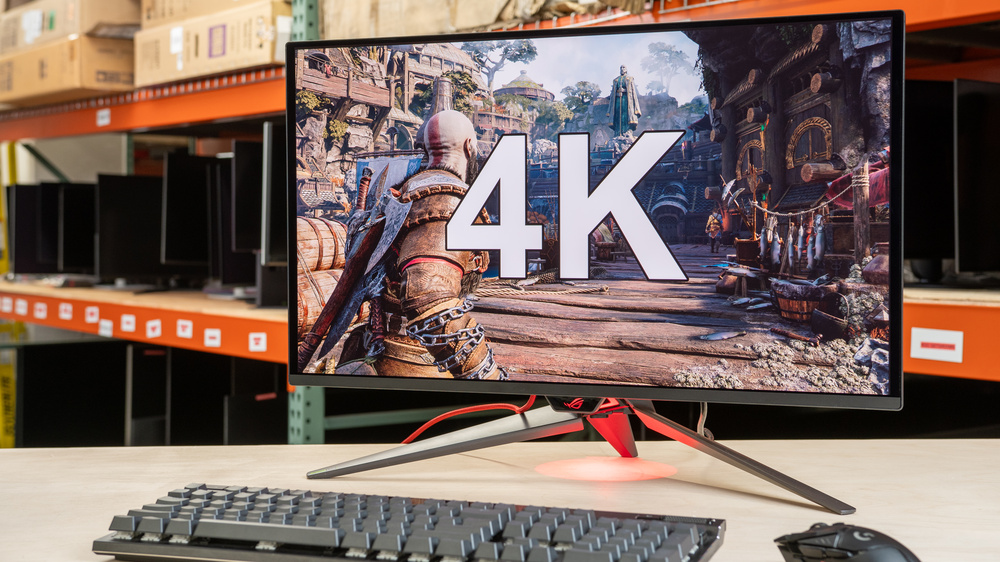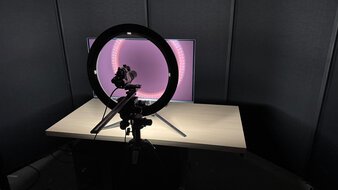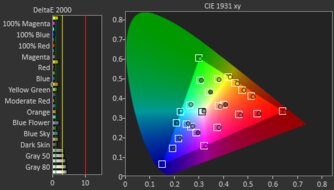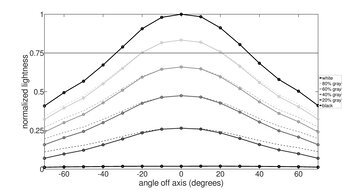A 4k gaming monitor is a great choice for an immersive gaming experience with detailed and sharp images. They're becoming more popular and easier to find than in the past, including at different price points, so there are plenty of options to choose from. However, while there are some cheap, entry-level 4k models available, those usually have limited gaming performance, so it's better to spend more on a dedicated 4k gaming monitor.
There are a few factors to think about when looking for a 4k gaming monitor. It's important to consider the monitor's response time for crisp motion and low input lag for a responsive feel, but most monitors have low input lag anyway. For the best gaming experience, you'll want something with HDMI 2.1 and DisplayPort 2.1 bandwidth to take full advantage of the latest graphics cards or gaming consoles. Although it's hard for computers to maintain high frame rates with a 4k resolution, there are 4k monitors available with refresh rates up to 240Hz. Lastly, displays with high contrast and bright highlights also help improve your gaming experience with good HDR picture quality.
We've bought and tested more than 370 monitors, and below are our picks for the best 4k gaming monitors. Also, see our recommendations for the best monitors for Xbox Series X, the best monitors for PS5/PS5 Pro, and the best 4k 144Hz monitors.
Quick Look

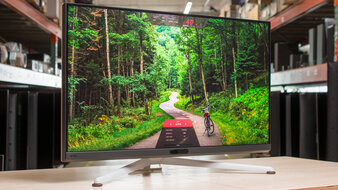




We buy and test more than 30 monitors each year, with units that we buy completely on our own, without any cherry-picked units or samples. We put a lot into each unbiased, straight-to-the-point review, and there's a whole process from purchasing to publishing, involving multiple teams and people. We do more than just use the monitor for a week; we use specialized and custom tools to measure various aspects with objective data-based results. We also consider multiple factors before making any recommendations, including the monitor's cost, its performance against the competition, and whether or not it's easy to find.
-
Best 4k Gaming Monitor
 PC Gaming9.1Console Gaming9.4Response Time9.9HDR Picture9.4SDR Picture10Brightness7.2Size27"Pixel TypeQD-OLEDMax Refresh Rate240 HzSee all our test resultsNative Resolution3840 x 2160
PC Gaming9.1Console Gaming9.4Response Time9.9HDR Picture9.4SDR Picture10Brightness7.2Size27"Pixel TypeQD-OLEDMax Refresh Rate240 HzSee all our test resultsNative Resolution3840 x 2160The best 4k gaming monitor we've tested is the ASUS ROG Swift OLED PG27UCDM. It's exceptional for gaming while offering incredible picture quality. With a QD-OLED panel, it has a near-instantaneous response time, resulting in sharp motion, and its 240Hz refresh rate is high enough for most gamers. Plus, it supports both HDMI and DisplayPort 2.1 bandwidth, which is useful if you have a graphics card that can take full advantage of either port. This also means it can make full use of the PS5, PS5 Pro, and Xbox Series X|S, and it also supports Dolby Vision with an Xbox, which many monitors can't do.
Besides its high-end gaming performance, it makes your favorite games look detailed thanks to its high 4k resolution. With high pixel density, text and images look sharp, too. Plus, it displays deep and inky blacks in dark rooms, makes small highlights pop, and has vivid colors, so it's a fantastic choice for HDR gaming. However, this monitor is expensive, and you can also check out the Dell Alienware AW2725Q if you want a similar 240Hz QD-OLED at a lower cost. That said, it lacks DisplayPort 2.1 bandwidth and is less accurate in HDR.
-
Best Upper Mid-Range 4k Gaming Monitor
 PC Gaming7.9Console Gaming8.5Response Time8.3HDR Picture7.6SDR Picture7.4Brightness9.3Size32"Pixel TypeIPSMax Refresh Rate144 HzSee all our test resultsNative Resolution3840 x 2160
PC Gaming7.9Console Gaming8.5Response Time8.3HDR Picture7.6SDR Picture7.4Brightness9.3Size32"Pixel TypeIPSMax Refresh Rate144 HzSee all our test resultsNative Resolution3840 x 2160If you don't want a premium OLED and you prefer saving just a bit of money to get a Mini LED option instead, then look into the BenQ MOBIUZ EX321UX. As it's not an OLED monitor like the ASUS ROG Swift OLED PG27UCDM, it doesn't display the same deep blacks without any haloing, but there are a few advantages thanks to its Mini LED display. It gets much brighter than the ASUS, so it's a better choice to use in well-lit rooms, and highlights really pop in HDR. It also has an okay local dimming feature that improves the black levels, which is great considering it has a low native contrast ratio.
Although this monitor doesn't deliver the same near-instantaneous response time as the ASUS, motion still looks sharp thanks to its fast response time across its VRR range. It also has features you'd expect to find in a gaming monitor, like VRR support and HDMI 2.1 bandwidth. That said, if it's still too much out of your price range, the Sony INZONE M9 II is another good choice. It has similar gaming performance, but because it doesn't use Mini LED backlighting, it has slightly worse picture quality than the BenQ.
-
Best Mid-Range 4k Gaming Monitor
 PC Gaming7.6Console Gaming8.2Response Time7.2HDR Picture6.3SDR Picture7.1Brightness8.4Size27"Pixel TypeIPSMax Refresh Rate480 HzSee all our test resultsNative Resolution3840 x 2160
PC Gaming7.6Console Gaming8.2Response Time7.2HDR Picture6.3SDR Picture7.1Brightness8.4Size27"Pixel TypeIPSMax Refresh Rate480 HzSee all our test resultsNative Resolution3840 x 2160If you're looking for a 4k gaming monitor in the mid-range price category, the LG 27G850A-B is a great choice. It's different from the BenQ MOBIUZ EX321UX in a few ways because it doesn't have Mini LED backlighting. It has a much worse local dimming feature because of this, and combined with its lower overall contrast ratio, blacks look gray in dark rooms, and highlights don't pop in HDR. However, this is what you have to expect for a lower-end 4k monitor.
What makes the LG great is its gaming features. It has a native 240Hz refresh rate, so it provides a smooth feel, and it's a good choice for playing competitive games. It supports all common VRR formats and has a good response time with most refresh rates, but there's noticeable blur with fast-moving objects. Its biggest advantage, though, is its dual-mode feature that boosts the refresh rate to 480Hz with a 1080p resolution. This is ideal if you play games that require the highest frame rates. You can also consider the Dell Alienware AW2725QF, which is another dual-mode monitor that costs less. However, its max refresh rate is 360Hz.
-
Best Budget 4k Gaming Monitor
 PC Gaming7.1Console Gaming8.0Response Time7.7HDR Picture5.0SDR Picture7.1Brightness7.7Size27"Pixel TypeIPSMax Refresh Rate144 HzSee all our test resultsNative Resolution3840 x 2160
PC Gaming7.1Console Gaming8.0Response Time7.7HDR Picture5.0SDR Picture7.1Brightness7.7Size27"Pixel TypeIPSMax Refresh Rate144 HzSee all our test resultsNative Resolution3840 x 2160There are a few options you can choose from if you're looking for the best budget 4k gaming monitors. Although entry-level 4k gaming monitors tend to cost more than other simple 4k monitors, like those meant for work, they're worth getting for gaming. If that's what you're interested in, the LG 27GR93U-B is a good choice, but there are a few trade-offs versus the LG 27G850A-B. It doesn't have a dual-mode feature, so you can't boost its 144Hz refresh rate to anything higher. It doesn't get as bright as the 27G850A-B in HDR either, so highlights don't pop.
Despite the difference in picture quality, it's good for gaming, with a fast response time at most refresh rates. It supports HDMI 2.1 bandwidth and supports most signals with gaming consoles. You can also look into the larger LG 32GR93U-B if you want a bigger screen. It's very similar to the 27GR93U-B and actually has better motion handling, but it costs more, so you're paying extra for the larger screen.
-
Best Cheap 4k Gaming Monitor
 PC Gaming6.1Console Gaming7.3Response Time4.2HDR Picture4.9SDR Picture7.4Brightness7.2Size27"Pixel TypeIPSMax Refresh Rate120 HzSee all our test resultsNative Resolution3840 x 2160
PC Gaming6.1Console Gaming7.3Response Time4.2HDR Picture4.9SDR Picture7.4Brightness7.2Size27"Pixel TypeIPSMax Refresh Rate120 HzSee all our test resultsNative Resolution3840 x 2160If you want a simple and cheap 4k monitor that has some gaming perks, look into the Dell S2725QS. It costs much less than the LG 27GR93U-B, which is why it's a good choice if you're on a limited budget. There are some downsides to getting it, though, as it has a lower refresh rate than the LG and much worse motion handling, so there's blur behind fast-moving objects. This means it's not a good choice for playing action games, but it's still useful for playing slower-paced games.
Despite its cheap price, it has some useful gaming perks, which is a nice touch for an entry-level model. Its HDMI 2.1 bandwidth and 120Hz refresh rate mean that it takes advantage of modern gaming consoles. It also supports all common VRR formats and has low input lag for a responsive feel. However, it's limited in perks otherwise, as it doesn't even have an audio jack or a USB hub, so you need to make sure your computer has those ports available if you want to connect devices.
Notable Mentions
-
LG 32GS95UE-B:
The LG 32GS95UE-B is a premium 240Hz monitor that's different from the ASUS ROG Swift OLED PG27UCDM. It has a dual-mode feature that boosts the refresh rate to 480Hz with a 1080p resolution. This is useful if you're a competitive gamer, but the lower resolution delivers less detailed images than at 4k.
See our review -
ASUS ROG Swift OLED PG32UCDM:
The ASUS ROG Swift OLED PG32UCDM is a premium 32-inch, 240Hz, QD-OLED monitor that's a larger alternative to the ASUS ROG Swift OLED PG27UCDM. It performs similarly for the most part, but it lacks DisplayPort 2.1 bandwidth and costs more.
See our review -
MSI MPG 272URX QD-OLED:
The MSI MPG 272URX QD-OLED is a 240Hz QD-OLED like the ASUS ROG Swift OLED PG27UCDM. The MSI usually costs less, so it's something to consider if you're on a budget, but it isn't as bright as the ASUS in SDR.
See our review -
Dell S2725QC:
The Dell S2725QC is an entry-level 4k monitor that has the same gaming features as the Dell S2725QS. It also has some extra perks, like a USB hub, but it costs more.
See our review
Recent Updates
Oct 23, 2025:
We removed the Gigabyte AORUS FO32U2P because it's hard to find. We also replaced the Samsung Odyssey Neo G8 S32BG85 with the BenQ MOBIUZ EX321UX for consistency with other recommendations. We replaced the Acer Nitro XV275K P3biipruzx, which is hard to find, with the LG 27G850A-B, and added the Dell S2725QS as the 'Best Cheap 4k Gaming Monitor' to give another option. In the Notable Mentions, we replaced the Dell Alienware AW3225QF and the LG 32GR93U-B with the MSI MPG 272URX QD-OLED and the Dell S2725QC.
Jul 14, 2025:
We replaced the MSI MPG 321URX QD-OLED with the Gigabyte AORUS FO32U2P because the MSI is harder to find, and for consistency with other recommendations.
Apr 18, 2025:
We added the ASUS ROG Swift OLED PG27UCDM and renamed the MSI MPG 321URX QD-OLED to the 'Best 32-Inch Monitor' to better represent the current monitor market.
Feb 19, 2025:
We introduced a new format to the article and updated the text to reflect these changes.
Jan 22, 2025:
We replaced the Samsung Odyssey OLED G8/G80SD S32DG80 with the MSI MPG 321URX QD-OLED as the MSI is cheaper, and for consistency with other recommendations. We also replaced the Gigabyte M27U with the LG 27GR93U-B because the Gigabyte is hard to find. Lastly, we replaced the Sony INZONE M9 and the MSI MAG 274UPF with the ASUS ROG Swift OLED PG32UCDM and the LG 32GR93U-B in the Notable Mentions to better reflect the current market.
All Reviews
Our recommendations are based on what we think are the best 4k gaming monitors currently available. They're adapted to be valid for most people in each price range. The rating is based on our review, factoring in price and feedback from our visitors.
If you'd prefer to make your own decision, here's the list of all of our 4k monitor reviews. Be careful not to get too caught up in the details. Most monitors are good enough to please most people, and the things we fault monitors on are often not noticeable unless you really look for them.
